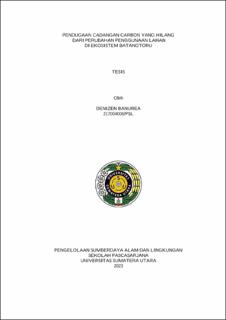Pendugaan Cadangan Carbon yang Hilang dari Perubahan Penggunaan Lahan di Ekosistem Batangtoru
Estimation of Carbon Stock Loss Due to Land Use Change in The Batangtoru Ecosystem

Date
2023Author
Banurea, Denizen
Advisor(s)
Aththorick, T Alief
Rahmawaty
Metadata
Show full item recordAbstract
Comprehensive information on carbon stocks across various forest types and land uses is still limited. Existing references are scattered across multiple publications and are not yet integrated at either the national or sub-national levels. Meanwhile, carbon stock data and emission factors are crucial for various entities, including government institutions, non-governmental organizations, and climate change mitigation practitioners. The objectives of this study are: 1) To analyze land cover types in the Batangtoru Ecosystem in 2005, 2010, 2015, and 2020; 2) To assess land cover changes in the Batangtoru Ecosystem over the same periods; and 3) To estimate the carbon sequestration and carbon loss in the Batangtoru Ecosystem during 2005, 2010, 2015, and 2020. This research was conducted in the Batangtoru Ecosystem, which spans 24 sub-districts across three regencies in North Sumatra Province. The study was carried out from December 2022 to January 2023. The research involved two stages of analysis: spatial analysis of land use changes and estimation of CO2-eq emissions resulting from land use changes in the Batangtoru Ecosystem, using a carbon stock- based approach known as the Stock Difference Method. Land use change analysis was conducted by interpreting Landsat imagery for the Batangtoru Ecosystem area. The process involved delineating the research area and performing geometric corrections. The results indicate that based on land use reclassification, land cover conditions from the 2000, 2006, 2011, 2015, and 2020 Landsat images identified eight land cover types: primary dryland forest, secondary dryland forest, mixed gardens, settlements, paddy fields, open land, swamps, and water bodies. The largest land cover in 2020 was secondary dryland forest, covering 74,017.7 hectares, while the smallest was swamp, covering 5.9 hectares. The most significant reduction in land cover from 2000 to 2020 was in shrubland, with a loss of 9,061.6 hectares. In contrast, secondary forest showed the most significant increase, expanding by 7,461 hectares, while the smallest increase occurred in water bodies, with an addition of 17.1 hectares. The highest total carbon stock in the Batangtoru Ecosystem was recorded in 2020 at 15,129,508.5 tons of carbon, while the lowest was in 2015, at 14,782,160.1 tons of carbon.
